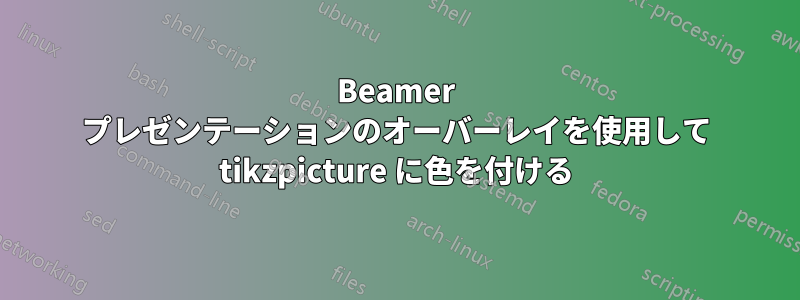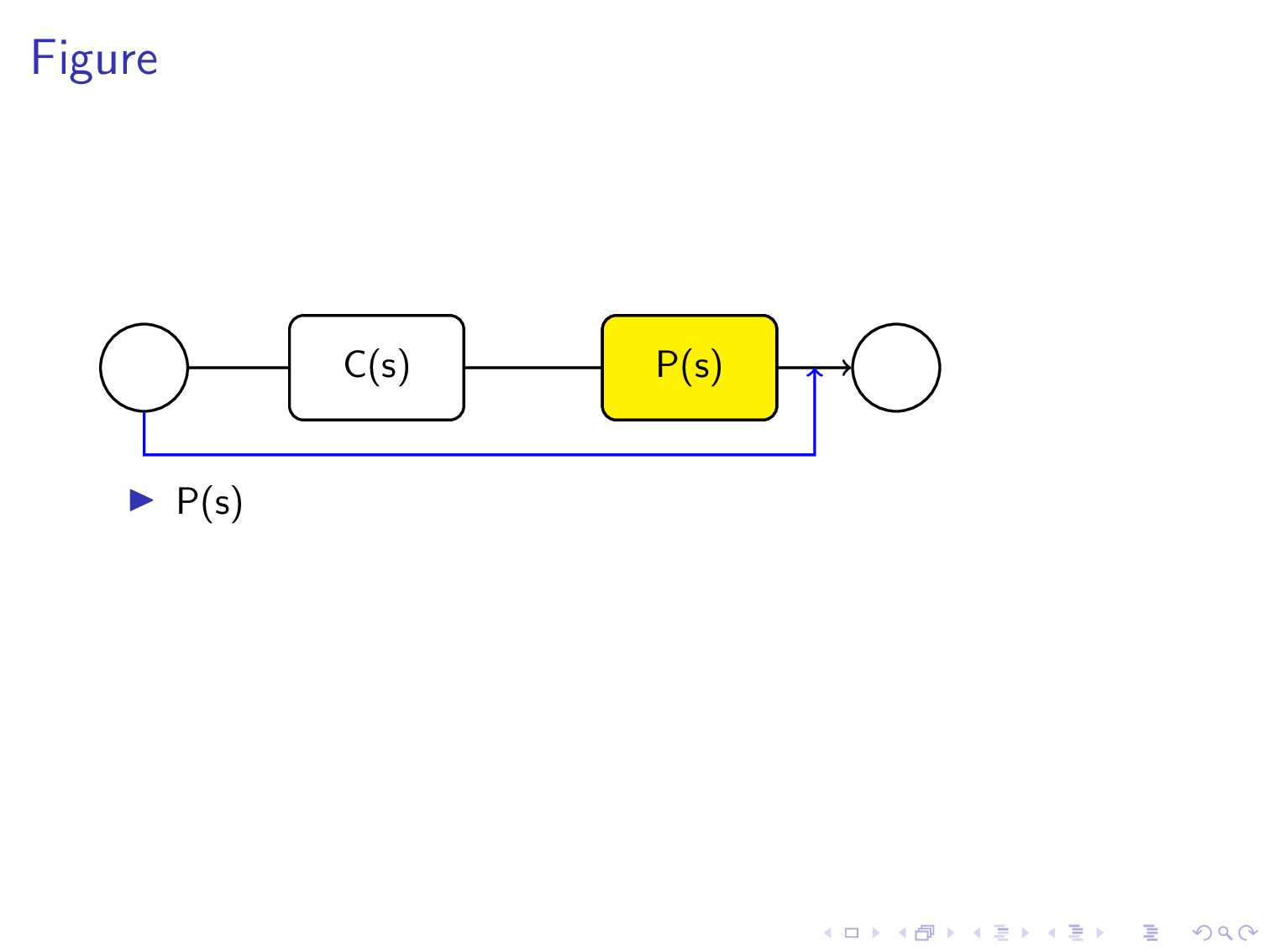
以下のコードは、P(s) と C(s) の 2 つのブロックで構成されるブロック ダイアグラムを示します。これらの 2 つのブロックも、リストに個別の項目として表示され、マウスをクリックするとそれぞれ表示されます。聴衆の注意を引くために、最初のスライドに P(s) の最初の箇条書きが表示されたら、ブロック ダイアグラムの P(s) を示す対応する角丸四角形に色を付けます。また、C(s) の 2 番目の箇条書きが表示されたら、ブロック ダイアグラムの C(s) の角丸四角形に色を付けます。どうすればこれを実現できますか。
\documentclass[compress, xcolor=table, usenames,dvipsnames]{beamer}
\usepackage{tikz}
\begin{document}
\tikzset{every picture/.style={line width=0.75pt}} %set default line width to 0.75pt
\begin{frame}{Figure}
\begin{tikzpicture}[x=0.75pt,y=0.75pt,yscale=-1,xscale=1]
%uncomment if require: \path (0,235); %set diagram left start at 0, and has
height of 235
%Rounded Rect [id:dp22728745820859309]
\draw (134,66.75) .. controls (134,62.33) and (137.58,58.75) ..
(142,58.75) -- (196,58.75) .. controls (200.42,58.75) and (204,62.33) ..
(204,66.75) -- (204,90.75) .. controls (204,95.17) and (200.42,98.75) ..
(196,98.75) -- (142,98.75) .. controls (137.58,98.75) and (134,95.17) ..
(134,90.75) -- cycle ;
%Rounded Rect [id:dp23074367111159821]
\draw (254,64.75) .. controls (254,60.33) and (257.58,56.75) ..
(262,56.75) -- (316,56.75) .. controls (320.42,56.75) and (324,60.33) ..
(324,64.75) -- (324,88.75) .. controls (324,93.17) and (320.42,96.75) ..
(316,96.75) -- (262,96.75) .. controls (257.58,96.75) and (254,93.17) ..
(254,88.75) -- cycle ;
%Straight Lines [id:da3785057523496602]
\draw (205,77.75) -- (251.5,76.79) ;
\draw [shift={(253.5,76.75)}, rotate = 538.8199999999999] [color={rgb,
255:red, 0; green, 0; blue, 0 } ][line width=0.75] (10.93,-3.29) ..
controls (6.95,-1.4) and (3.31,-0.3) .. (0,0) .. controls (3.31,0.3) and
(6.95,1.4) .. (10.93,3.29) ;
%Shape: Circle [id:dp7405273795099738]
\draw (350,76.5) .. controls (350,66.7) and (357.95,58.75) ..
(367.75,58.75) .. controls (377.55,58.75) and (385.5,66.7) .. (385.5,76.5)
.. controls (385.5,86.3) and (377.55,94.25) .. (367.75,94.25) .. controls
(357.95,94.25) and (350,86.3) .. (350,76.5) -- cycle ;
%Straight Lines [id:da4768143479707079]
\draw (323.75,77) -- (349.25,77) ;
\draw [shift={(351.25,77)}, rotate = 180] [color={rgb, 255:red, 0; green,
0; blue, 0 } ][line width=0.75] (10.93,-3.29) .. controls (6.95,-1.4)
and (3.31,-0.3) .. (0,0) .. controls (3.31,0.3) and (6.95,1.4) ..
(10.93,3.29) ;
%Shape: Circle [id:dp9725542364076398]
\draw (70,78.5) .. controls (70,68.7) and (77.95,60.75) .. (87.75,60.75)
.. controls (97.55,60.75) and (105.5,68.7) .. (105.5,78.5) .. controls
(105.5,88.3) and (97.55,96.25) .. (87.75,96.25) .. controls (77.95,96.25)
and (70,88.3) .. (70,78.5) -- cycle ;
%Straight Lines [id:da10367925110615261]
\draw (105.5,78.5) -- (135.75,78.5) ;
\draw [shift={(137.75,78.5)}, rotate = 180] [color={rgb, 255:red, 0;
green, 0; blue, 0 } ][line width=0.75] (10.93,-3.29) .. controls
(6.95,-1.4) and (3.31,-0.3) .. (0,0) .. controls (3.31,0.3) and (6.95,1.4)
.. (10.93,3.29) ;
%Straight Lines [id:da3384320385828452]
\draw (87.75,136) -- (341.75,136) ;
%Straight Lines [id:da9706282263267894]
\draw (341.75,136) -- (341.75,77) ;
%Straight Lines [id:da01968558683101662]
\draw (87.75,137) -- (87.75,96.25) ;
% Text Node
\draw (289,76.75) node [align=left] {P(s)};
\draw (169,76.75) node [align=left] {C(s)};
% Text Node
\end{tikzpicture}
\beamerdefaultoverlayspecification{<+->}
\begin{itemize}
\item P(s)
\item C(s)
\end{itemize}
\end{frame}
\end{document}
答え1
ベジェ曲線を使用して長方形や円を段階的に描くあなたの勇気と忍耐力に感心します。
これを実現できたなら、TikZ がこれらすべての計算を自動的に実行することを計画していることを知って興味を持つかもしれません。
この目的のために、TikZ は と呼ばれるものを作成しましたnode。 は、nodeテキストを含む円形、長方形、またはその他の図形です。
ノードを使用する利点は、tikz が一方から他方に向かう矢印をインテリジェントに描画することです。つまり、矢印は端から端まで進み、(要求されない限り) 内部を貫通しませんnode。
私は、あなたの素晴らしいコードを、Tikz ノードを使用する短いコードに削除する権利を留保しました (お詫び申し上げます)。ただし、寸法は pt のままにしました。
www.DeepL.com/Translator(無料版)で翻訳
\documentclass[compress, xcolor=table, usenames,dvipsnames]{beamer}
\usepackage{tikz}
\usetikzlibrary{positioning,calc}
\begin{document}
\tikzset{every picture/.style={line width=0.75pt}, %set default line width to 0.75pt
skip loop/.style={to path={--++(0,25pt) -| (\tikztotarget)}},
filled/.style={draw,rectangle,minimum height=30pt,fill=yellow,minimum width=50pt,rounded corners},
unfilled/.style={draw,rectangle,minimum height=30pt,minimum width=50pt,rounded corners},
cercle/.style={draw,circle,minimum size=25pt}}
\begin{frame}{Figure}
\begin{tikzpicture}[x=0.75pt,y=0.75pt,yscale=-1,xscale=1]
\node[cercle](initial) at (80,78.5){};
\node[unfilled,right =of initial](second){C(s)};
\node[unfilled,right = 39pt of second](third){P(s)};
\node[cercle,right =21pt of third](terminal){};
\draw[->](initial)--(second)--(third)--(terminal);
\path[blue,->] (initial)edge[skip loop]($(third.east)!.5!(terminal.west)$);
\node<1>[filled]at(third){P(s)};
\node<2>[filled]at(second){C(s)};
\end{tikzpicture}
%\beamerdefaultoverlayspecification{<+->}
\begin{itemize}[<+->]
\item P(s)
\item C(s)
\end{itemize}
\end{frame}
\end{document}
答え2
繰り返しになりますが、以前の回答ここで、この状況にぴったりのパッケージがあることを述べておきますoverlay-beamer-styles。これは、塗りすぎやジャンプを防ぐのに役立ちます。
\node[box,highlight on=<1>](B1){$\mathsf{C}(\mathsf{s})$};
C最初のスライドのノードを強調表示します。
\documentclass{beamer}
\usepackage{tikz}
\usetikzlibrary{chains,overlay-beamer-styles}
\tikzset{highlight on/.style args={<#1>}{alt=<#1>{fill=yellow}}}
\begin{document}
\begin{frame}[t] % https://tex.stackexchange.com/a/518055/194703
\frametitle{A scintillator}
\begin{center}
\begin{tikzpicture}[circ/.style={circle,inner sep=3.2mm,draw},
box/.style={draw,rounded corners=3pt,minimum width=16mm,minimum height=8mm},
line width=0.75pt]
\begin{scope}[start chain=going right,nodes={on chain,join},
every join/.style={-stealth}]
\node[circ](C1){};
\node[box,highlight on=<1>](B1){$\mathsf{C}(\mathsf{s})$};
\node[box,highlight on=<2>](B2){$\mathsf{P}(\mathsf{s})$};
\node[circ](C2){};
\end{scope}
\path (B2.east) -- coordinate (aux)(C2.west) ;
\draw[-stealth](aux) --++ (0,-1cm) -| (C1);
\end{tikzpicture}
\end{center}
\begin{itemize}[<+->]
\item P(s)
\item C(s)
\end{itemize}
\end{frame}
\end{document}




